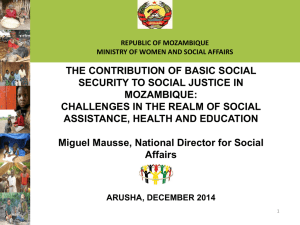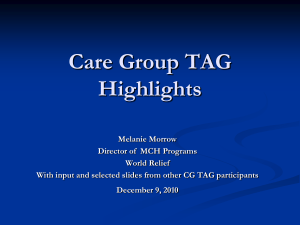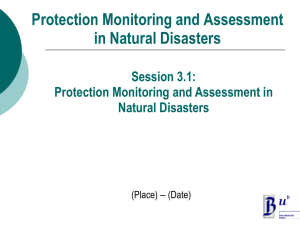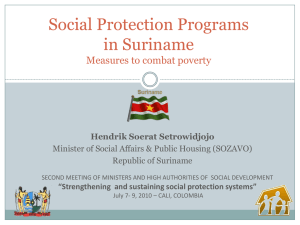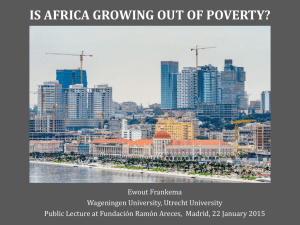Mozambique social protection framework
advertisement
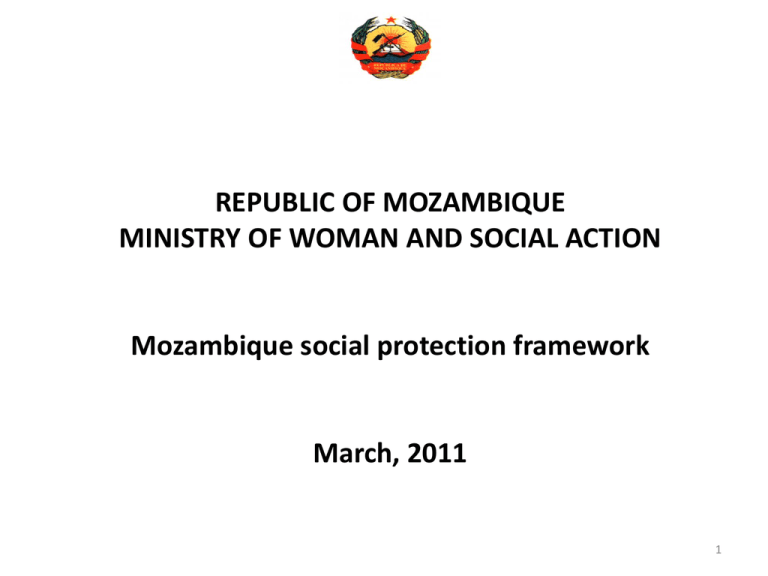
REPUBLIC OF MOZAMBIQUE MINISTRY OF WOMAN AND SOCIAL ACTION Mozambique social protection framework March, 2011 1 STRUCTURE 1. 2. 3. 4. Mozambique - Basic data Social Protection context Main Pillars of Social Protection Coordination of the Basic Social Protection Initiatives 5. The National Strategy of Basic Social Security 6. Funding 7. Challenges 2 BASIC DATA OF MOZAMBIQUE • Population: • • • • • Women: Children under 18: Children headed household: Chronic malnutrition The spread of HIV and AIDS • Chefes 6.149 Chefes 20.5 million (54.7 bellow poverty line 2008/2009) 52% About 10 million 6.149 46.4% (2009) (in 2009 the national prevalence rate stood at 16% in people aged 15-49 3 2. CONTEXT OF SOCIAL PROTECTION • In 2007, Mozambique adopted the Social Protection Law (Law No. 4/2007, of 07 February). • The Law defines the social protection as a system endowed with appropriate means to satisfy social needs mandating the distribution of income, within the framework of solidarity among members of society. • The Law establishes the right to social protection and defines 3 levels of the social protection structure: – Basic Social Security; – Compulsory Social Security; – Complementary Social Security. 4 2. CONTEXT OF SOCIAL PROTECTION (Cont.) • Predicting the Subsystem Basic Social Security as one of the levels of social protection in Mozambique, drives the process of strengthening the most vulnerable people, and open space to define sustainable mechanisms to protect them against risks and vulnerabilities. • In 2009, the Government of Mozambique adopted the Regulation of the Basic Social Security, which sets out principles and standards appropriate to this Subsystem. The Basic Social Security: • Aims to prevent situations of need, as well provides social integration by supporting most vulnerable groups. • It is based on a national solidarity, reflecting distributive characteristics; • It is mostly funded by the State Budget. 5 2. CONTEXT OF - BENEFICIARIES SOCIAL PROTECTION • This Subsystem covers national citizens living in absolute poverty, without means to satisfy their basic needs, including: – Children in difficult situation; – Elderly (55 years woman and 60 years old man); – People with disabilities; – People chronically ill and with degenerative diseases. 6 3. MAIN PILARS OF SOCIAL PROTECTION The Basic Social Security provisions includes: – provisions of risk, these are the set of support measures granted by the State based on goods, products, services or granting monetary amounts intended to mitigate the risks and ensure the survival of people living in absolute poverty and in a state of vulnerability (cash transfers for people incapable to work, Social transfers for a fixed period to ensure access to services in response to temporary situations of vulnerability ). – provisions of social support comprising the grant by the State or nongovernmental organizations to support access to services, implementation of programs or projects that guarantee social and economic integration through work, targeting individuals or groups of individuals with special needs at housing, health care, food, among others. 7 3. MAIN PILARS OF SOCIAL PROTECTION (Cont.) The main pillars of the basic social protection are: – Direct Social Action, managed by the Ministry which oversees the area of social action, aims to ensure the recipients (that are permanent or temporary incapable to work) an access to a monetary or non monetary values to satisfy their basic needs; – Social Action in Health, managed by the Ministry which oversees the area of health, aims to ensure universal access for populations most vulnerable to primary health care, including measures that can improve the quality of their health; 8 3. MAIN PILARS OF SOCIAL PROTECTION (Cont.) – Social Action in Education, managed by the Ministry which oversees the area of education, aims to encourage the participation of vulnerable groups in the education system. – Productive Social Action, the management is shared by the Ministries that oversees the areas of social action, planning and development, agriculture, labor, public works and housing. To ensure social inclusion through work (Ex. public works), in response to a situation of chronic food insecurity, exacerbated by the shocks, structural risks and impacts of environmental changes. 9 4. COORDINATION OF BASIC SOCIAL PROTECTION INITIATIVES • According to the Social Protection Law, the Ministry responsible for Social Action have the responsibility to manage the Basic Social Security System with the participation of non governmental entities with social interests and other services of State administration. • The subordinated institution of this Ministry, the National Institute of Social Action, have the responsibility to implement social assistance programs, mainly in the pillar of Direct Social Action. Also intervene in the productive social action. • Coordination - In December 2009, through the regulation of the basic social protection subsystem, was created the Coordinating Council of the Basic Social Security Subsystem, an entity responsible to coordinate the implementation of this subsystem, which comprises the Ministers responsible for the management of the main pillars presented, as well as representatives of public and private entities connected to the area of social action. 10 4. COORDINATION OF BASIC PROTECTION INITIATIVES – SOCIAL (Cont.) Apart from the Council, there are some platforms to establish the dialogue with Government, civil society organizations and other partners such us: • The Group of Social Action, created in 2008, coordinated by the Ministry of Woman and Social Action. Is a specif group that works in mainstreaming the social action in PRSP; • The “Food Subsidy Program” Support Group (was created in 2008 to monitor the implementation and progresses of this Program). 11 5. THE NATIONAL STRATEGY OF THE BASIC SOCIAL PROTECTION • Taking into account the needs and the role of basic social security, in April 2010, was approved the National Strategy of Basic Social Protection for 20102014, aligned with the Government Program 2010-2014. • The Government of Mozambique found essential to prepare a framework that allows defining the main orientations in the area of Basic Social Protection, in order to better prepare to meet the objectives set out in the legal instrument for the basic social protection subsystem. • Until 2014 by implementing the Strategy, a total number of 523.000 (54%) of the households of aged people, people with disabilities and people with chronic diseases will be covered through the regular monetary social transfers. 12 5. THE NATIONAL STRATEGY OF THE BASIC SOCIAL PROTECTION • In terms of beneficiaries, the objective of the NSBSS is to cover through different types of programs a total number of 945.382 households until 2014 by : – A monetary transferences to households of Aged people, people with disabilities and people with chronic diseases; – A monetary transferences for households headed by Orphans and Vulnerable Children; and – A National Program of Productive Social Security the designing process will start this year. • Challenge: All these initiatives will cover 20% of the households living in absolute poverty. 13 5. THE NATIONAL STRATEGY OF THE BASIC SOCIAL PROTECTION The Strategy was approved taking in account that: • The regular transfer of income contributes to the reduction of absolute poverty ; • Institutionalized social protection programs should better support the contribution of this important pillar to economic development; • It is important to ensure maximum impact of the transfers made; • Is important to focus efforts on programs where is possible to have greatest comparative advantage; • Is important to define more efficient mechanisms of eligibility; • The response to food and nutrition insecurity requires the involvement of basic social protection ; • The civil society organizations are important partners in providing social assistance to vulnerable groups; • Better coordination is needed . 14 6. FUNDING • The regulation of the basic social protection subsystem defines the gradual implementation of the benefits taking in account the economic situation of the country. • The current social assistance programs are funded by State Budget. PSA is a Government-led non-contributory social security program with continuous funding by State Budget over a period of almost 15 years. • In 2008, some donors (DFID, Embassy of Netherlands, start to give direct support to PSA). UNICEF, ILO are involved in technical and capacity building support in the basic social protection pillar. • To implement the NSBSS 2010-2014, is necessary to increase the State Budget funding for social assistance programs from the current 1% to 2.16% in 2014. • The Strategy defines the need to define more creative ways to fund the basic social protection programs such us the analysis on how to maximize the fiscal space (the process will start this year). 15 7. CHALLENGES • Define/redefine the social protection programs; • Increase the financial resources available in the social area. Create new sources of revenues to cover the increase of the amount of the benefits • Increase the advocacy and sensibility of society and decision makers in the issues of social protection; • Increase gradually the coverage of the basic social protection in terms of beneficiaries; • Create new benefits to cover different types of needs and to reach the vulnerable households (the need of redesign the basic social protection programs); • Improve the mechanisms of coordination within the different sectors involved (mainly social action, education, health and the sectors involved in the implementation of programs for people capable to work)-Establish the Council; • Emphasize the importance of the social protection in the PRSP. 16
